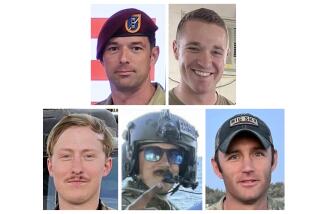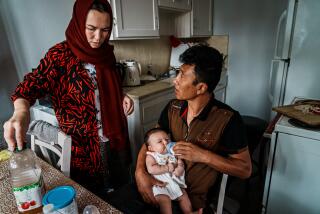Coalition Forces Change Strategies
BAGRAM, Afghanistan — The six soldiers stood at attention in the old Soviet airplane hangar Friday to receive Purple Hearts, the medal reserved for Americans wounded in combat.
One was a helicopter pilot grazed in the head by shrapnel when a rocket-propelled grenade shattered the cockpit of his aircraft. Others were infantrymen caught in a terrifying 18-hour mortar assault on the first day of Operation Anaconda in eastern Afghanistan.
The men were praised for their sacrifice and courage by a phalanx of generals assembled in the leaky old building--a decrepit remnant of the last foreign military force to operate in Afghanistan. But the emotional ceremony also underscored a change in tactics that has put U.S. ground troops square on the front lines in the war against Al Qaeda and Taliban forces.
Initially, American commanders had hoped that local Afghan fighters would take the lead in the attack launched last weekend, with U.S. and coalition forces assuming blocking positions outside.
“We want the Afghans to go after these guys. It’s their country,” Maj. Gen. Frank L. Hagenbeck told reporters in an operation briefing Feb. 26.
But when the Afghan forces proved ineffective and the American “blockers” came under immediate, intense fire, the plan was quickly reversed.
On Friday, Col. Joe Smith, chief of staff for the 10th Mountain Division here at Bagram air base, said the attack forces were now arranged in “concentric circles: Afghan forces on the outside and the rest of coalition forces on the inside,” like an anaconda suffocating its prey.
The results have been striking: According to U.S. commanders, more than 500 “hardened Al Qaeda fighters” have been killed in six days of ground fighting.
Ground fire from the Al Qaeda and Taliban holdouts has eased in recent days, officials said Friday at the Pentagon.
But the Pentagon believes that perhaps 200 fighters are still entrenched in the caves, tunnels and cliffsides, a senior Pentagon official said.
“We’ve seen sporadic firing, sporadic fighting” in the last several days, said Air Force Brig. Gen. John W. Rosa Jr., deputy director of operations for the Joint Chiefs of Staff. “The fighting we saw in the first day has not been as intense. But it’s still a very dangerous place.”
Rosa told reporters at the Pentagon that “a couple hundred” Al Qaeda remain in the mountainous battlefield but said their losses appear to have reduced their ability to organize defenses.
Defense Secretary Donald H. Rumsfeld said foul weather had slowed the pace of U.S. aerial bombing, but Rosa said later that the weather Friday night in Afghanistan had improved.
Rosa said U.S. aircraft, B-52 bombers, Navy fighter jets, Apache attack helicopters and AC-130 gunships among them, had flown more than 200 missions Friday and dropped 75 bombs.
Rumsfeld also said he expects the battle would last seven to 10 more days. On Thursday, he said it could end as early as this weekend, although in both instances he cautioned it is impossible to know for sure how long the militant fighters will hold out.
The battle against the holdouts has had a high price: It has resulted in the highest level of U.S. dead and wounded in the Afghan war.
Of the 43 men who landed in the Chinook helicopter with Army Sgt. David Smith and other members of Charlie Company early Saturday morning, 12 were wounded. So far, eight Americans have died in Operation Anaconda, with dozens more wounded.
“Honestly, all of us thought we were going to die,” said Smith, of Philadelphia, a squad team leader whose legs were gashed by a mortar explosion and who was one of the Purple Heart recipients Friday.
The U.S. fighters, set down in what they were told was a secure area, spent most of the time dragging their fallen comrades to a series of hiding places to avoid the incoming mortars until more troops transported by two Black Hawk helicopters came to their aid under cover of night.
Miraculously, none of the Americans was killed. A chaplain at the Purple Heart ceremony offered a prayer for “keeping the men alive when death was all around them.”
*
Times staff writer Esther Schrader in Washington contributed to this report.
More to Read
Sign up for Essential California
The most important California stories and recommendations in your inbox every morning.
You may occasionally receive promotional content from the Los Angeles Times.









